Greetings!
And in a week when Korea is in the news again for all the wrong reasons, (well… North Korea is), then is it not apt that Uncle Travelling Matt explores the country further, revving up for the time when he visits the border with the World’s Naughtiest Nation? That however, will be next week, providing of course, that Korea, be it North or South, has not been reduced to a nuclear wasteland by then.
Mind you, if it has, fear not, I’ve already got a travelogue on Chernobyl waiting to be posted as well!
Keep travelling!
Uncle Travelling Matt
Links to all parts of the travelogue
Book 1: Embarking Upon a New Korea
1e: Seoul, Incheon and Across the Yellow Sea
Book 2: Master Potter does Fine China
Book 3: Steppe to the Left, Steppe to the Right…
14th July, 2002 - Pusan, South Korea
I woke much earlier than I’d expected (or wanted) to the next day, or to be more exact, just into the next day, firstly at one in the morning, then just before two and then just after. The reason for my nocturnal restlessness was a simple one, mosquitoes. Now these pesky little bleeders (literally), are (I am thankful to say), rarely much of a problem to me, and in the past I have slept peacefully whilst others have been forced to brandish the spray hours back. However, this lot were in a league of their own, and en masse too, and even I couldn’t cope. Eventually, around three, being able to stand it no longer, I got up, gave myself a good scratch, closed the window and hunted through the collection of sprays on the dressing table, until I found one with a picture of my foe on the front, and then sprayed every inch of the room. They dropped from the sky like flies, (which they sort of are I suppose), and that done, sleep not only came easily, but stayed. For me until morning, and for my insect friends, I am happy to say, forever.
As a consequence of all this however, my proper waking up when the day was light, came later than I’d intended, and it was almost lunchtime by the time I’d showered, shaved and prepared myself for the travails of the tourist. Consequently, before heading off to see the sights, I first stopped off for some fodder at the Lotteria by the metro station.
Lotteria, (which I’d first discovered back in Japan and mistakenly believed to be Japanese at the time), is Korea’s spectacularly mediocre answer to McDonalds. Not only does it serve rather tasteless burgers and average coffee, but its colour scheme is red and yellow, and the staff have silly uniforms too. Haute cuisine it is not, but I frequented it because it is Western, (despite being Korean). Now before the travel purists condemn me outright for being yet another Western ignoramus afraid to experience the local cuisine, I must state in my defence that I do try local foods, and sometimes I even like them. In fact, wherever I am, as a rule I tend to eat as much local food as is possible, (it tends to be cheaper), although of course, if local food is not available, I tend to as much food of any type, full stop, as is possible. But, I do draw a line, and that line is the mornings. Mornings are sacred times, the day is new and the stomach is weak. Mornings therefore, should not be polluted by strange foodstuffs, and instead the stomach requires bread, meat, perhaps potatoes and other proper foods. The salads, rice, noodles and other exotica, whilst undoubtedly (?) pleasant, must wait. The morning is the preserve of real sustenance, washed down by a nice hot cup of tea. And Lotteria, whilst being far from perfect, does provide both, and thus to Lotteria did I go.
Lotteria: Korean class
After having finished my teriyaki burger meal, (you see, even before lunch I make some concessions to the local cuisine), and cup of tea, I was ready to go on and see the sights of Pusan, Korea’s second city. The main sight (according to my guidebook), was however just out of the city, the Kunjong-gu fortress, a sort of Korean Masada without the famous suicide pacts. Well, it sounded interesting to me, so I hopped onto the Metro to the nearest stop and then took a taxi to the renowned citadel. However, when deposited at the site by my driver, I had to admit to being a little confused as to where the famed fortress, (or indeed, any fortress), actually was, for he seemed to have dropped me off in a small mountain village.
“Kunjong-gu?” I queried. Taximan nodded slowly whilst pointing at the meter. Hmm… He drove off as soon as I paid him, and I decided to have a look around, taking the uphill lane since in my experience, fortresses tend to be more easily defended if they are the top of a hill, (smart, eh?). However, after a kilometre or so, my lane petered out by a plain Buddhist temple and an outside toilet. Confused, I asked a woman if here be Kunjong? She nodded in the affirmative. “Kunjong-GU” I repeated, pointing out the words in my guidebook. This time there was a shake of the head and a point of the fingers in the direction of a nearby hill. So that was it! The driver had taken me to the village Kunjong, and not the fortress! Quite why he might have thought that I would want the village I know not, but he obviously did and that’s where I now was. Thus, there was only one thing for it, and that was to head back down the main road and take another taxi to the fort itself.
Whilst walking back down I had a good look around me at what was most likely to be the only traditional Korean village that I would ever visit. It’s houses were generally but one storey and like elsewhere in the Orient, few rooms seemed to contain chairs, instead families were sat on the floor eating their midday meal. Generally speaking it looked plainer and perhaps a little poorer than it’s Japanese counterparts that I had visited, but the difference was small, and it was a world away from the poverty-stricken villages of the continent’s south-east. All the homes appeared to have running water and electricity, were well-maintained and on the metalled roads four wheel drives sat outside the homes of their owners. No, South Korea is nowadays without doubt no longer a poor country, and no doubt as the years roll by, it will be getting much richer.
I was deposited near to the East Gate of the fort, which was situated on the top of an atmospheric, misty, boulder-strewn hill. Walking up to it I really got a feel of the mysterious and exotic east and I half expected fearsome and strangely-clad warriors to burst forth from the handsome and well-proportioned gate up ahead of me. That illusion however was completely shattered upon arrival at that said structure, which turned out to be but a post-war reconstruction, populated not be warriors, but a mackintosh-clad army of ramblers.
There was unfortunately very little left of what must once have been an extremely impressive complex, with outer walls stretching for a distance of over seventeen kilometres. The fortress was started in 1703 but not completed until 1807. From then on it did its best to defend a troubled corner of a much-attacked land, before being destroyed by the Japanese in the twentieth century.
After consulting the map, I decided to walk along the path that followed the perimeter wall to the cable car terminal near to the South Gate, several kilometres hence. I started along, enjoying the serenity and scenery, but not so much the misty dampness. After some time I reached a road with a few shops, so I decided to buy some mineral water to quench my thirst. The liquid that I bought however, in the mineral water-esque green bottle, turned out to be not the bounty of the skies, but some brand of unpalatable local moonshine made from rice. Too shy to admit my mistake to the stallholder, I took one sip, before putting it deep inside my bag with the intention of perhaps drinking it later.*
The path, which seemed to go on forever, eventually brought me to the cable car station, adjacent to which stood a restaurant. Being somewhat hungry and still thirsty from my long trek, I decided to call into the latter and order some local dishes, (it now being past lunchtime). Confronted with a mass of hangul however, this proved a somewhat difficult task and I was about to reach for my guidebook, when a kind, English-speaking diner decided to assist me. He turned out to be a resident of the city and recommended bibinda, a famous dish of stodge created by mixing rice, meat, kimchi, and various vegetables together in a large hot pot. I’d tried this before and quite enjoyed it, being a bit of a fan of stodgy food, (you have to be if you’re British), so I gave it a go whilst talking to my helpmate about Korean life and his job as a dentist. After thanking him, I paid up and moved onto the cable car which I ended up sharing with the first Westerners that I’d seen so far, a group of portly Kiwis who, (I gathered from their conversation), were teachers in the city.
Now I, (and this will become increasingly apparent throughout the course of this travelogue), am a big one for cable cars, tall towers or big hills; in other words any place that enables me to get up high and see how the land lies, or how the place that I’m visiting is arranged as it were. Perhaps it comes from looking at too many maps as a kid, I don’t know, but whatever it is, wherever I go, I always try to get up as well as get around.
Consequently, when it comes to cable cars and chairlifts, I’ve been on quite a few over the years. Few, if any however, have been up to the standard of that one from Kunjong-gu to the city of Pusan. For the entire distance from the misty mountain top to the suburban bottom, a stunning vista of the seaside city was laid out before me. I picked out the centre, the Metro line which I’d arrived here on and the impressive Main Stadium, only a month back the setting for Korea’s World Cup 2-0 defeat of Poland. And nearer to, there was the mountain slopes, littered with boulders and trees, the greenery punctuated occasionally by the graceful roof of a temple.
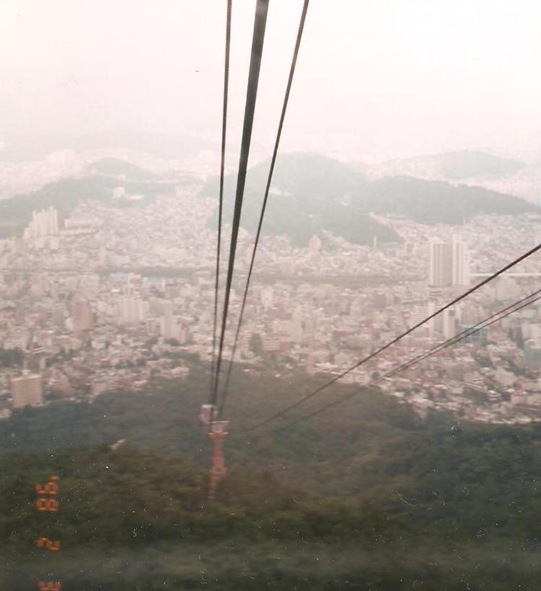 The cable car from Kunjong-gu to Tongnae
The cable car from Kunjong-gu to Tongnae
But a love of being above it all was not the only reason behind my decision to take the cable car to return down the mountain. Indeed there was another very important extra factor in my reckoning, for the cable car’s lower station is in an area of the city named Tongnae, and that was a place that I definitely wanted to go to, as it is the home of one of the most famous oncheon in the land.
Those of you with a good memory will remember that oncheon is the Korean for the Japanese term onsen, and that onsen was what my travelling companion on the ferry had been to Japan to sample. Yes indeed, oncheon are those hot spring resorts, beloved by the locals and generally found in the peninsula's mountains. Tongnae however, is an exception. It’s an urban oncheon and consequently, due to its convenient location, very popular.
Popular it might be, but easy to find it was not. However, if in doubt, ask. I found the locals to be very friendly and despite the lack of a common tongue, after several visits to small shops and a lot of pointing and gesturing, I found myself at the huge Tongnae Public Baths Complex.
Having lived in Japan for two years I’d tried a lot of, and grown to adore onsens, and as such I was eager to try the Korean variant. What would the differences be? Upon entering there appeared to be few; queue up, buy a ticket, take off your shoes, take of all your clothes, wash thoroughly and then enter.
‘Take off all your clothes,’ did you say? Surely sir you can’t be serious! How uncivilised, like a Roman orgy or something! Well, my prudent friend, I’m afraid I’m being perfectly serious, although alas you were wrong on the orgy count. Nakedness is the order of the day with both onsen and oncheon, and for a shy Brit like I, that took some getting used to at first, my prudence delaying my first entry into the world of oriental bathing by over a month. However, once bitten, forever smitten, and by this time I batted not an eyelid at the sight of a vast damp room full of small men in their birthday suits.
Another thing that also takes a bit of getting used to is the fact that bathing out East is for relaxation, or health purposes, and not for getting clean. Indeed, climbing into a bath unwashed is one of the biggest cultural faux pas that one may commit, and so first stop is always the showers, where one soaps and scrubs every speck of grease and grime away. And that done, it’s time to step out and experience oncheon.
I was not disappointed.
As a general rule, for an oncheon to be worth its salt, it should boast more than just a pool of mineral water. A Jacuzzi pool, outdoor pool, sauna and perhaps a plunge pool of icy H2O are common attractions. More luxurious oncheon may also include a bath of something else, tea or salt water perhaps, or a massaging waterfall maybe. Tongnae Oncheon however was in a league of its own. In the two hours or so that I spent under its vast domed glass roof I experienced, (in the company of hundreds of naked Korean men), the following:-
- A yellow sand bath
- ·A hot bath
- ·A hotter bath
- ·Even hotter, ouch!
- ·A cold bath
- ·Brrr…! Too cold bath.
- ·Outside bath
- ·Yellow soil sauna
- ·Wet sauna
- ·Dry sauna
- ·Caves with artificial waterfalls
- ·Chinese medicines bath
- ·Green tea bath
- ·Brown tea bath
- ·What sort of tea is that? Bath
- ·Salt water bath
- ·Foot massage walkway (with pebbles)
- Kiddies pool
- And a drinking fountain!
And all the aches and pains of eight hundred kilometres of rail travel, two hundred more by boat, a mosquito-infested sleepless night, and a long walk around a misty fort, were soothed away. I walked out of that oncheon declaring to myself two things, firstly that it was after all rather similar to its counterparts in Japan, and secondly that it was damn good!
I'd intended to visit the Pusan Tower, (big pointless sticky-up thing in the centre of town), after, and so took the Metro straight there, but alas, by the time that I'd climbed to its base, time was running short and so I climbed astraight back down again, and headed back to my hotel, paid the bill, grabbed my bags, and went to the railway station with fifteen minutes to spare.
Upon arrival at the station however, I found that, like the Japanese, the Koreans employed that annoying system of not letting one down onto the platform before showing one's ticket for the waiting train, so I opened my bag and rummaged for the required article.
And rummaged, and rummaged, and rummaged. But strangely not ticket was to be found, and more worryingly, no passport either. Tickets are replaceable. Passports are too, but the visas for China, Kazakhstan, Uzbekistan and Russia that were in the passport... Yes, I had a problem, and there was nothing else for it, but to rush back to the hotel.
Now the hotel proprietor, (who spoke not a word of English), was more than a little surprised to see his supposedly departed guest back so soon, and even more reluctant to let me back into my room, as it was now occupied by someone else. Fortunately however, by hurried and broken Japanese, with a strong emphasis on the words 'passport' and 'bedroom', I convinced him, and so we rushed up the stairs and I dived into the (luckily vacant) room, and hunted around.
Now, no passports were immediately apparent, but I, being a perennially messy kinda guy, had a good idea where it might have got to, and with all my strength I hauled the double bed away from the wall and lo, discovered not only my key to Trans-Asian adventures, but also the ticket for my train to Seoul which was departing in five minutes time, several leaflets detailing the attractions of Pusan, some Korean won, a smelly pair of socks, an even smellier pair of pants and a paperback copy of Jule Verne's Eighty Days Around the World, all of which I hurriedly gathered in my arms, and thanking the proprietor en route, ran flat out to the station, grabbed my baggage and hurtled down to the Seoul-bound express, literally being the last to board, just as she was a-rolling out of the station.
Now following that mad rush, I was as mentally and physically shattered as I possibly could be and needed nothing more than a good sit down and a rest. And luckily, I had over four hours of just that ahead of me, sat on the train. The grand green and yellow diesel slowly drew through the suburbs of Pusan and I settled down to enjoy a new country in the most civilised manner possible. From a railway carriage.
And what a journey it was too! Once out of the city, we followed the mighty Nakdong River, its calm waters framed by majestic mountains behind and looking like a picture-postcard representation of a classic Asian scene. This was the land of dragons, temples and fantasies that I'd hoped to find, and I revelled in it.
Travelling through Korea at high-speed was fascinating and quite often revealed some unexpected sights. Naturally she was similar to Japan, young steep mountains, virtually uninhabitable, the people clustered on the plains below, but yet at the same time, she was different as well. For a start, there were less people and the plains less-crowded. Agriculturally, there was a notable amount of market gardens, the vast greenhouses penned in-between the river and the railway. The towns differed also, the houses sturdier and squatter, and not a temple in sight, in their place countless neon cross-topped churches proclaiming the glory of a Christian God, and on one hillside a huge Catholic seminary stood, with an enormous Christ over the doorway, arms outstretched, welcoming Asia into His Kingdom.
Christianity in Korea is an interesting phenomenon. After the Philippines, South Korea is the most Christianized country in the Far East, and whilst the unrelentless sowing of seeds by missionaries has largely fallen on stony ground in this part of the world, (just over one percent of the population in Japan, in China a mere thirty million believers out of a population of 1.3 billion), the seeds of faith have returned great yields on the peninsular and of today's sixty million South Koreans, over a quarter profess to be Christian and that number is growing.
Quite why they have been so successful however, is something of a mystery. Perhaps it is a wish to distance themselves from their old oppressors in China and Japan, or perhaps Christ provides a welcome refuge and security from the harsh and ever-threatening atheism of their Northern brothers, who knows? But whatever the reasons may be, Christianity, particularly of the modern, evangelical Protestant variety, is well-established and is increasingly popular, particularly amongst the country's youth.
Despite all of that though, the fact still remains that is a quarter of the population is Christian, then the remaining three quarters must be something else. And, officially at least, that something else, is a mixture of Buddhism and Shamanism, the country's two traditional belief systems, with a history dating back thousands of years. A mere traveller through the country however would be hard-pressed to imagine this to be the truth, and indeed I, who had read about this situation beforehand, struggled to believe it to be true. To all intents and purposes, South Korea appears to be not only a predominantly Christian country, but a fanatical one at that.
The reasons for this illusion are two-fold. Firstly, there are the Christians themselves, who are, as I said earlier, largely Protestant and Evangelical. And Evangelical Christianity is by its very nature, a strain that likes to advertise itself and shout about what it is. Consequently, any church, no matter if humble or huge, seems to be topped by an enormous cross, and at night these crosses light up proclaiming to all that whilst not everyone here might be Christian, those who are are very pleased with their faith.
And then there's the Buddhists. More than the profusion of glow-in-the-dark Houses of Christ, the abject lack of any signs of Buddhism whatsoever help create the illusion that Christ is entirely in control. Whereas the Japanese landscape is littered with the graceful roofs of shrines or temples, they are noticeably absent from the townscapes of Korea. In every town that we passed through, I gazed out eagerly for any hint of the Buddha, and each time I was disappointed. The reason for that too is simple; Korean Buddhist temples look like normal houses and are humble in the extreme, only discernable as a place of worship by the large mirror-image of a swastika on the door. They are numerous, but not apparent from a speeding train.
I moved into the restaurant car for some curry and rice, and got talking to the waiter who spoke excellent English. I asked him about the large concrete highway that had been following us for some time now and was evidently still under construction.
“Oh, that's not a highway,” he said, “it's the new high-speed railway due to open in 2010 that will link Seoul with Pusan.” And then he optimistically added. “And perhaps also it will be extended to China and Russia?” Will that dream one day come true? A railway through North Korea which we may travel on freely. And perhaps even more? When I'm retired will I be able to make the journey the other way, from Stoke-on-Trent to Toyama, all the way by high-speed train alone?
But for the present my train was fast enough and pleasant too. Around Daejon, the country's big city in the centre, darkness fell, so I returned to my seat and settled down to Jules Verne whose hero was travelling a lot further than I and in only eighty days! Well, if that was theoretically possible in the second half of the nineteenth century, then perhaps my dream for the second half of the twenty-first is not so unrealistic?
Arriving at Seoul I quickly transferred to the Metro and journeyed to Itaewon, the city's sleaze district, to meet up with the Highlander, an old comrade from my school days who now resided and toiled near to the South Korean capital.
I found him to be much the same as ever and we retired to an excellent German-owned bar that he frequented, (“the GIs don't get here,” explained he), for a long catch-up, having not met up for several years, a chat which I won't bore you the reader with, as it involved only people and places that you are no doubt unfamiliar and uninterested in.
Later on however, we moved onto the subject of Korea, and the Highlander had some interesting things to say. The one that surprised me the most was when I mentioned Korean girls. “Don't even think about it,” he said, “for us ex-pats by and large they're out of bounds.” That surprised me since in Japan relations between the local ladies and foreign men were notoriously common. “Not so here,” said the Highlander, “the virgin bride is still expected in Korea.” That contrasts greatly with her neighbour, yet another example of the fact that the two countries, on the surface so similar, are in many ways profoundly different.
Another difference is that Japan is not chopped in two, with an impoverished northern neighbour ready to invade at a moment's notice. “Ever wondered why the streets of Seoul are so wide?” remarked my Highland friend. “Easier for moving troops around.” Just before my visit, the US's enlightened President, George W. Bush, had made one of his typically bombastic remarks, by including Korea's North in his imagined 'Axis of Evil'. What effects had that had I asked?
“Well, just between ourselves it caused a few feathers to be ruffled,” my friend replied. “A GI acquaintance of mine says that following it all American troops were issued with gas-masks and put through biological warfare training.”
But could the North Koreans successfully invade the South these days, what with no Chinese support and fifty-thousand American troops in the country?
“It's doubtful, but what matters is the damage that they could do first. Remember, Seoul is only fifty kilometres from the border and most of the country's wealth and power is centred here. They might fail, but they could virtually destroy the South in the process.”
The Highlander's residence was not in Seoul itself, but around fifty kilometres to the south in a town called Anseoung. We got there by bus and taxi, (and in doing so I learnt that Koreans don't queue and Korean buses don't necessarily stop!), arriving in the early hours, whereupon I put my head to the pillow and fell fast asleep after what had been a very long day.
The Highlander
* I never did though; it ended up left in our hotel room in Seoul after the Lowlander found that he too, couldn’t stomach more than a mouthful.
Next part: 1c: Seoul
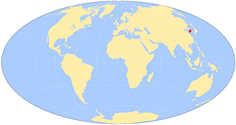
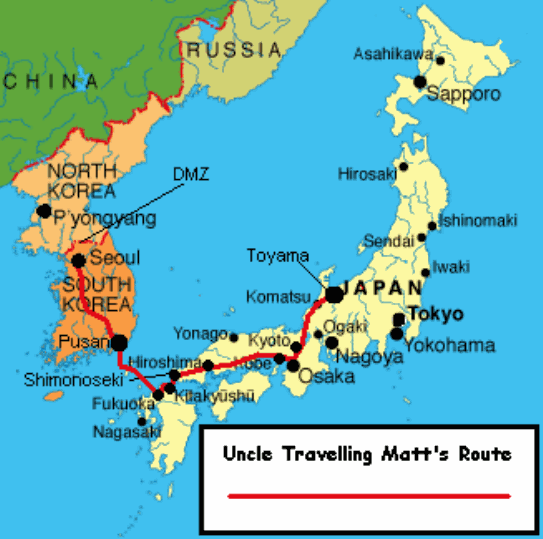
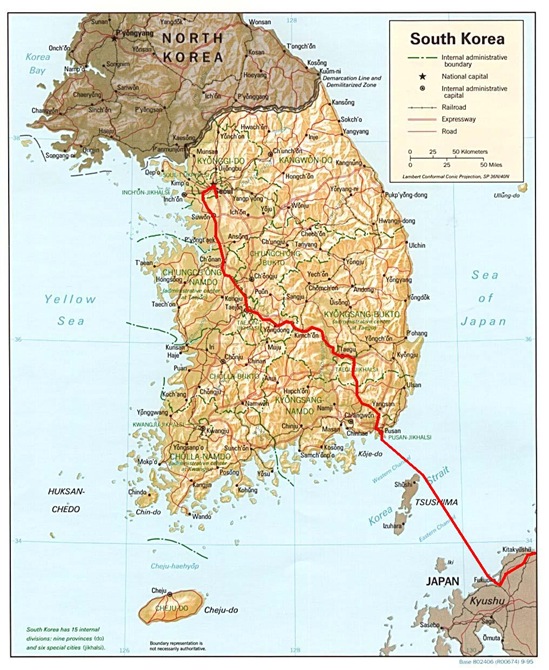
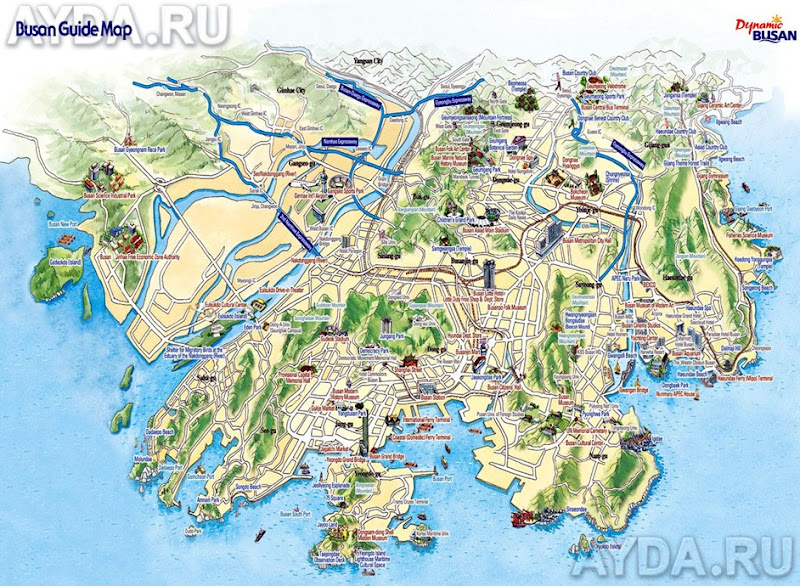


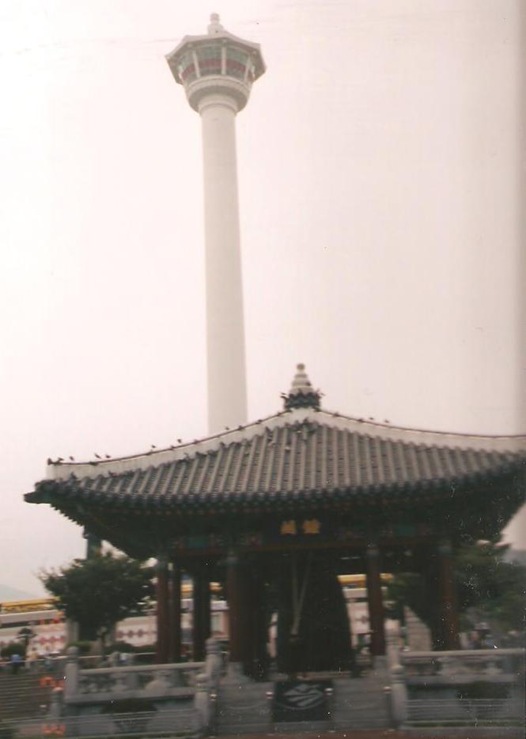
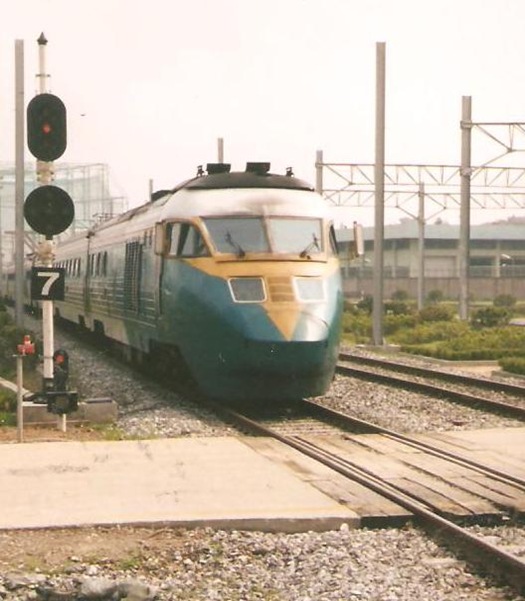
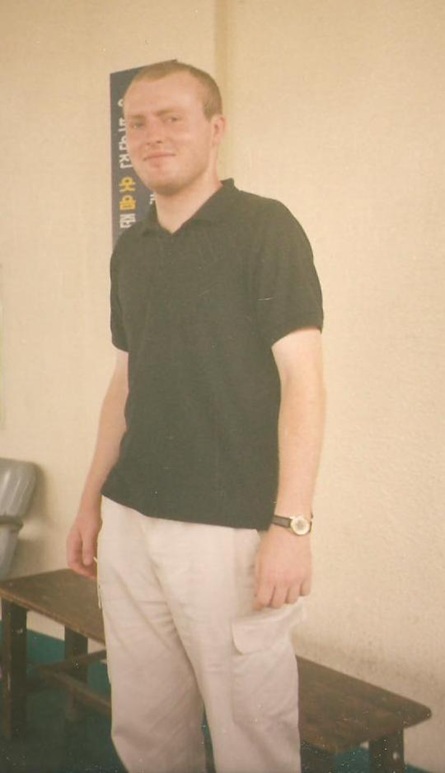
Living in quaint Nippon I am used to Japanese chopsticks. I had trouble using Korean ones when I visited there because they were long and flat and metal, different than Japanese ones...I don't know whether or not the Korean chopsticks were objectively more difficult to use or whether I just wasn't used to them. Do you have an opinion on said matter, U.T.M.? Now, some of those Korean men were rather nice to look at...
ReplyDeleteThe Hotaruika
Thanks for you comment Hotaruika and yes, I recall those metal chopsticks. The worry is if you've got metal fillings and you're not too hot with the hashi. Then it can get painful. Thanks for reading and check out the Japanese Musings with lots of stuff from my time in Toyama.
ReplyDeleteUTM